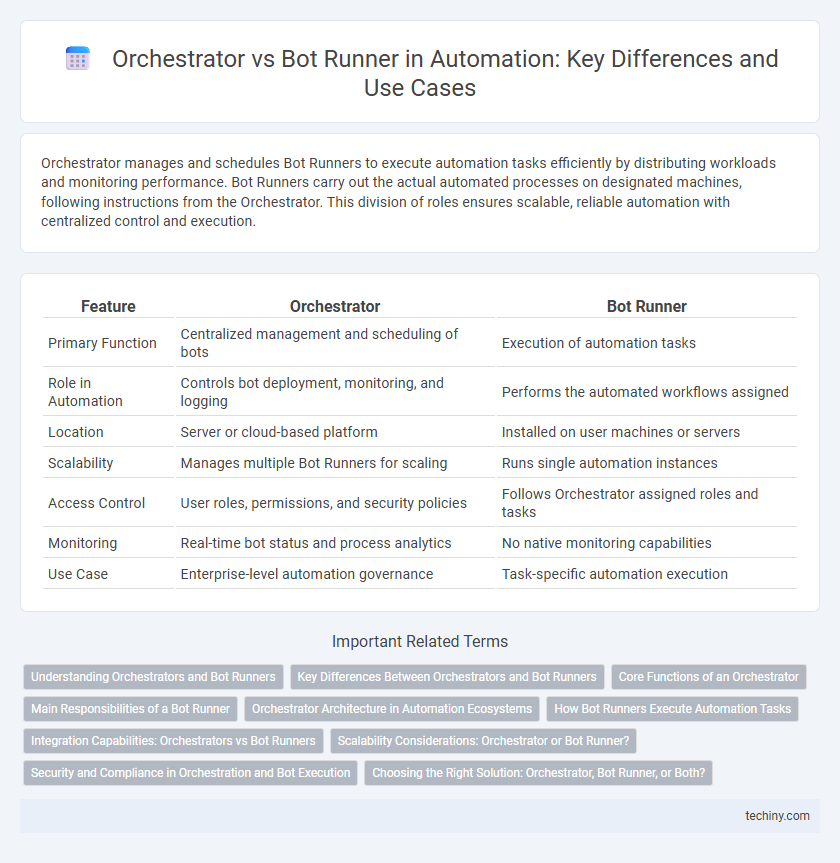Orchestrator manages and schedules Bot Runners to execute automation tasks efficiently by distributing workloads and monitoring performance. Bot Runners carry out the actual automated processes on designated machines, following instructions from the Orchestrator. This division of roles ensures scalable, reliable automation with centralized control and execution.
Table of Comparison
| Feature | Orchestrator | Bot Runner |
|---|---|---|
| Primary Function | Centralized management and scheduling of bots | Execution of automation tasks |
| Role in Automation | Controls bot deployment, monitoring, and logging | Performs the automated workflows assigned |
| Location | Server or cloud-based platform | Installed on user machines or servers |
| Scalability | Manages multiple Bot Runners for scaling | Runs single automation instances |
| Access Control | User roles, permissions, and security policies | Follows Orchestrator assigned roles and tasks |
| Monitoring | Real-time bot status and process analytics | No native monitoring capabilities |
| Use Case | Enterprise-level automation governance | Task-specific automation execution |
Understanding Orchestrators and Bot Runners
Orchestrators manage and schedule the execution of automated processes, handling asset management, queue processing, and monitoring job statuses across multiple Bot Runners. Bot Runners are execution agents that perform the actual tasks defined by automation scripts, running workflows on designated machines based on instructions from the Orchestrator. Understanding the interaction between Orchestrators and Bot Runners enables efficient scale and control of complex automation deployments within enterprise environments.
Key Differences Between Orchestrators and Bot Runners
Orchestrators manage and schedule multiple bots, providing centralized control, monitoring, and logging of automation processes, whereas Bot Runners execute individual tasks or automation scripts on designated machines. The Orchestrator handles workload distribution, user access, and version control, ensuring seamless coordination across enterprise environments, while Bot Runners focus solely on task execution without direct management capabilities. This separation enables scalability and efficient automation governance within complex workflows.
Core Functions of an Orchestrator
An Orchestrator manages and schedules automated workflows, ensuring seamless execution by allocating tasks to Bot Runners. Core functions include centralized monitoring, queue management, and credential handling, enabling efficient robot deployment and error recovery. This platform supports scalability and secure automation governance across multiple Bot Runners in enterprise environments.
Main Responsibilities of a Bot Runner
A Bot Runner is responsible for executing automation scripts and processes as directed by the Orchestrator, ensuring seamless task completion across multiple systems. It operates the digital workforce by running attended and unattended bots, managing resource allocation during automation workflows. Bot Runners also monitor process performance and report execution status back to the Orchestrator for centralized control and optimization.
Orchestrator Architecture in Automation Ecosystems
Orchestrator architecture in automation ecosystems centralizes control by managing bot deployment, scheduling, and monitoring through a web-based interface, enhancing operational efficiency. It interacts with Bot Runners, which execute tasks, allowing seamless coordination and scalability across multiple environments. The robust architecture ensures secure credential management, audit trails, and real-time analytics, optimizing end-to-end automation workflows.
How Bot Runners Execute Automation Tasks
Bot Runners execute automation tasks by receiving assignments from the Orchestrator and performing the defined workflows on target machines. They operate in the background, handling processes such as data extraction, application integration, and rule-based decision-making without human intervention. Bot Runners communicate status and results back to the Orchestrator for centralized monitoring and management.
Integration Capabilities: Orchestrators vs Bot Runners
Orchestrators centralize automation management by coordinating multiple Bot Runners, enabling seamless integration with enterprise systems through APIs, queues, and custom connectors. Bot Runners execute individual automation tasks but rely on Orchestrators for advanced integration, scheduling, and monitoring. This division ensures scalable and efficient automation deployment across complex IT environments.
Scalability Considerations: Orchestrator or Bot Runner?
Orchestrator enables centralized management and scheduling of multiple Bot Runners, crucial for scaling automation across enterprise environments. Bot Runner executes automation tasks but relies on Orchestrator for coordinated workload distribution and monitoring. Scalability depends on Orchestrator's ability to allocate resources dynamically and balance execution loads among Bot Runners.
Security and Compliance in Orchestration and Bot Execution
Orchestrator centralizes security controls by managing authentication, role-based access, and audit logs to ensure compliance across all automation workflows. Bot Runner executes tasks in isolated environments with encrypted communication channels to prevent unauthorized data exposure during bot execution. Together, they enforce strict governance policies and real-time monitoring to maintain regulatory compliance and safeguard sensitive information.
Choosing the Right Solution: Orchestrator, Bot Runner, or Both?
Orchestrator manages, schedules, and monitors automated workflows, providing centralized control and analytics for enterprise-scale automation, while Bot Runner executes the bots on designated machines, enabling task automation across various environments. Choosing the right solution depends on organizational needs; Orchestrator suits businesses requiring robust governance and scalability, whereas Bot Runner fits environments focused on execution without centralized management. Combining both delivers end-to-end automation with centralized oversight and distributed execution, optimizing operational efficiency and control.
Orchestrator vs Bot Runner Infographic

 techiny.com
techiny.com